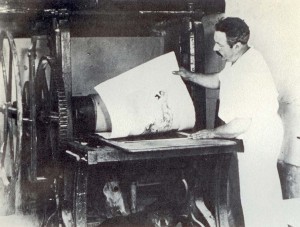If I post an entry every Monday to Friday, I’ve got to come up with over 250 posts per year, so I need ideas. Please suggest some to me. This one comes from my daughter, Nicole. She asked me to answer questions that are commonly asked of me at shows. I was asked this question on Sunday at the Redondo Beach Antiques Fair. “How can you tell an etching is authentic?”

Louis Icart pulling a proof of Joy of Life from the etching press
First you have to understand the process of producing an etching. The artist does his work on a copper plate, so the “original” is a copper plate and that’s rarely ever for sale. To produce the image, first the plate is hand-inked. Then the paper is laid down on top and the two pass together through the etching press, under tremendous pressure. The pressure transfers the image to the paper. Since the copper plate has thickness, it “dents” the paper around the edge of the image. This “dent” is called a plate impression. You can see it and feel it around the edge of the plate. So #1. A real etching has a plate impression.
Since the process is not photographic and there is no printing press, there are no dots in the image. If you use a magnifying glass to look at a photograph in a newspaper, you can see the entire image is made up of dots. Use a magnifying glass with an original etching and there are no dots. So #2. An authentic etching does not have any dots in the image.
After the edition is printed by the master printer, it is given back to the artist to hand-sign each one. Prints or other fakes have copies of the signature. So #3. Authentic etchings are hand-signed by the artist, usually in pencil.
In the case of Louis Icart, a raised seal called a blindstamp, was created in mid-1926, and is usually found in the lower left corner, just below the image. Most Icart images produced after this time have the blindstamp, but don’t use this information as a crutch. There are some fake etchings that have fake blindstamps. And conversely, there are many authentic Icart etchings that do not have a blindstamp. Supposedly the etchings without blindstamps were not for export from France, but personally I’ve found too many instances where this rule doesn’t seem to follow.
If you like my blog, please recommend it to others. Email me with your comments and suggestions. philchasen@gmail.com

Question; How can you tell if a woodcut is real?
I read the article on etchings, great information! Thank you so much!
I have an original handcolored etching with embossed with the ‘E M’ seal of the l’ Estampe Moderne on lower left corner. It is titled ” Publie par L’Estampe Modern 12 Rue Godot de Mauroi Paris 1920″ in top left and thenCopyright 1920 by the F.H.Bresler & Co Milwauke USA in top right. I am trying to find out who the artist is as i cannot read signature. I acquired this from my gradnmother 30 years ago and had refraamed professioanlly then. Any info in this artist?
The back of my Icart “Spring Blossoms”has this written in pencil 23/20-. Found it when I was having it reframed. What does it mean?
I have an all wood armoire that has a number etched into the wood into the wood on the back top of the armoire #246. Does this mean something.
I have an Woodblock print by Durer dated 1504,the Three Saints, brought
about 20 years ago from Park West gallery on a cruise ship. Is it worth very much?
I have a Louis Icart signed Don Juan with an embossed stamp in lower left corner and looks like an E.133 next to it. Also notation in top left corner Editions d’ Art December 23 R110 Lavoisier PARIS. Can you tell me about this? Thank you, Kim Shetrone.
I have a Colored Etching Titled DE GENDARME and has a Bicorne hat as the building sign with a Man, Woman and Dog in front of the building. The only markings seem to be the initials A.C. at top of the piece. Have not been able to identify. It appears to have been framed in the 1990s by The Frame co. Jupiter FL.
I have a etching #1of 3 signed Rembrandt 1639 it’s the famous man leaning on a sill which is actually Rembrandt. No dots. I’m trying to find out of the #1 or #3. What is the state #1 or #3?
I am at a loss as to why so many people are asking about other artists when the author clearly states he is an Icart expert, however; when Icart questions are asked, I can’t find answers. Will you be returning to answer? My question is in total, for each piece he did, how many truly authentic etchings are there? How many are thought to be in the USA? I seem to see far more than seems imaginable listed as original or authentic. I think some people just don’t research what they are selling, or buying.
I have a ICart Sleeping Beauty signed. The numbered 744/500. Can you please tell me what it’s worth ?